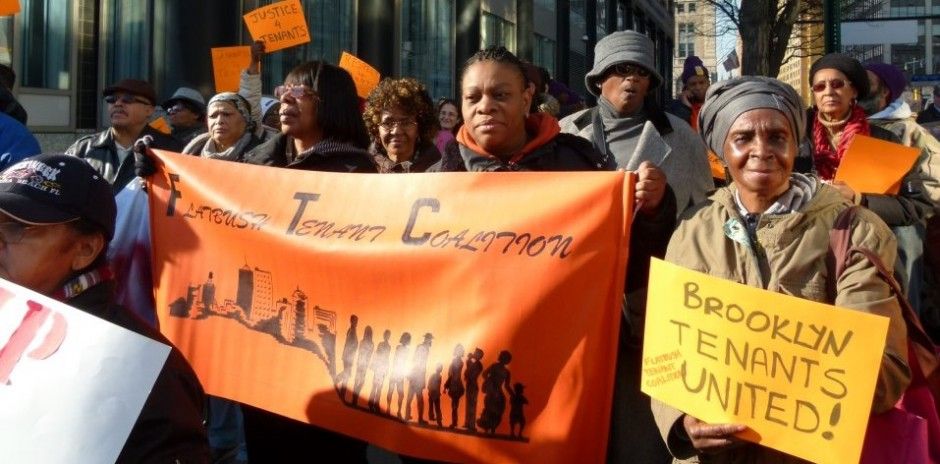Affordable Housing In Ditmas Park: Know The Basics

We recently reported on the rent-stabilized apartment where District 40 Council Member Mathieu Eugene may or may not live. But, while most renters in our area are probably familiar with terms like “rent stabilization” and “affordable housing,” we thought it might be timely to go over what those terms actually mean.
In the coming weeks and months, we’ll be posting a series of stories surrounding the issue of affordable housing in Ditmas Park and Flatbush at large. To begin, we spoke with Aga Trojniak of the Flatbush Tenant Coalition. An offshoot of the Flatbush Development Corporation, FTC is “a group of tenant associations in Flatbush, Brooklyn working collectively to build power in the tenant community.”
Aga, who we’ll be working with closely on future housing posts, helped us compile the following list of things you should know and rights you have if you’re like most people in Brooklyn and rent your apartment.
1. Find out if your building is rent regulated. If you signed a lease that looks like this, then your apartment is rent stabilized. Also, any building built before 1974 with six or more units in it is generally rent stabilized. (Although, Aga notes that major exceptions in our neighborhood are co-op buildings. If tenants rent from a co-op owner, they are not rent stabilized. If they rent from the co-op’s sponsor, they may be.)
So what does “rent stabilized” mean? It means that there are certain guidelines landlords have to adhere to, including the amount they can raise the apartment’s rent. That amount is tied to a percentage determined annually by the NYC Rent Guidelines Board. This year’s process is happening right now, with a public meeting on May 30th, a public hearing on June 13th, and a final vote on this year’s guidelines on June 20th. If you haven’t been paying attention to this, best to start.
2. Get your rent history. If your apartment is rent stabilized, you have the right to obtain a history of rent charged for your apartment. When an apartment is vacated, landlords are only allowed to raise the rent by a certain percentage, but there’s very little oversight. And if rent reaches $2,500/month, the apartment becomes unregulated, so they have an incentive to cheat. By obtaining your history, you can try to determine if your landlord is charging you an illegally high amount. To do so, Aga suggests contacting DHCR. Call 718.739.6400, press 1, then 7, and then ask for your complete rent history. They will mail it to your address. Once you’ve gotten your rent history, feel free to give Aga a call at 718.635.2623 for help understanding what it means.
3. Research whether your landlord has any current housing court cases. You can also look up open violations by building address on the NYC Department of Housing Preservation and Development’s website (theoretically — the HPDonline portal was not loading when we checked this morning).
4. Find out if there’s a tenant association in your building. If there isn’t, consider starting one. Aga says that FTC is comprised of 38 different tenant associations and that Flatbush has the most tenant associations of any area in the city. If you or your tenant association need help, contact Aga at trojniak@fdconline.org or like FTC on Facebook.
5. Know the difference between rent stabilized and rent controlled. You always hear that story of the grandmother who passed her Central Park West 4BR apartment down to her children, who passed it down to their children, who are now paying $250/month to live there. That’s a rent controlled apartment and, for the most part, that’s just what it is — a story. There are only about 39,000 rent controlled apartments in the city versus about one million rent stabilized apartments. You can read more about the difference here but you don’t have to have inherited your apartment from a relative for it to be subject to rent regulation.
6. Know what “affordable housing” really means. According to Aga (and the National Low Income Housing Coalition), the standard for affordable housing is when your rent is no more than 30% of your income. And, in this city, even that standard is somewhat questionable. Aga points out that the median income for rent regulated apartments is about $30,000 and, in Flatbush, 22% of tenants in rent regulated apartments live below the poverty line with an income of around $22,000 for a family of 4. As she says, “rent regulated apartments are the largest source of affordable housing” we have in this city.
6. Know your rights as a tenant. Strong as tenant rights are in NYC, they are gradually being weakened, says Aga. And she asks, when removing a tenant from their home, even for legitimate reasons, “is it unreasonable that it should take a few months to deny someone that right?”
7. Understand that the conditions you live in may not be the conditions your neighbor in the next apartment over lives in. Aga claims that, in an attempt to capitalize on the increasing trend toward gentrification in Flatbush, many of her tenants’ landlords beautifully renovate vacant apartments to attract higher rent while purposely neglect to do much needed repairs on the apartments of longtime tenants, hoping to force them to leave. This is one of the issues we’ll explore more deeply in future posts.
More on the affordable housing situation in Ditmas Park will be forthcoming. In the meantime, renters, get to know your own building and neighbors a bit. Let us know what you’re seeing and what the rest of the neighborhood should know. If you’d like to know more about tenant rights, Aga suggests checking out the following resources:
Fair Housing Justice Center – http://www.fairhousingjustice.org/
South Brooklyn Legal Services – http://www.sbls.org/
Legal Aid – http://www.legal-aid.org
(Incidentally, we’d also love to hear about responsible landlords doing the right thing by their tenants. We know they’re out there somewhere.)
Photo courtesy of Flatbush Tenant Coalition



